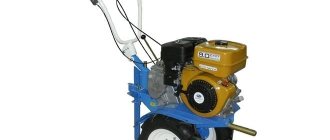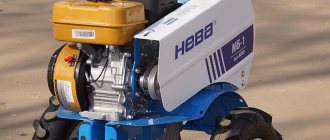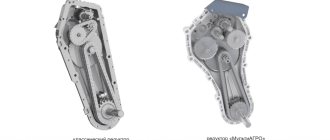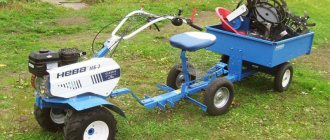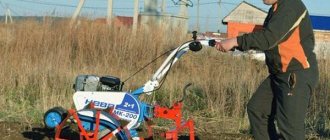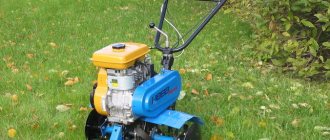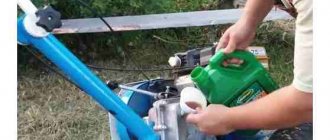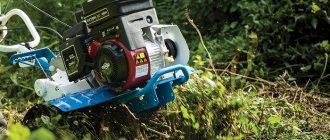The Neva MB 23 walk-behind tractor can cope with all work related to the cultivation of private soils. If you install attachments on it, it will be able to perform:
- watering;
- mowing grass;
- hay collection;
- cleaning of any areas;
- cargo transportation.
Thanks to their technical data, such walk-behind tractors can work even with very heavy soils. And the impressive range of transmission gears is the key to the required dynamics of movement and the required traction loads.
General information
Neva MB 23 is a device of several modifications with different types of power plants and attachments. In particular, the model is equipped with engines from Briggs & Stratton, as well as Subaru and Honda. Each modification differs in power and has different processing width and depth parameters. Power and weight may also vary. There are both petrol and diesel versions of the Neva MB 23.
Despite the variety of modifications, they are united by a single design. So, regardless of the configuration (even the basic one), the walk-behind tractor is equipped with a durable gearbox with an aluminum housing. The gearbox itself is gas-filled, gear-chain type. The parts in this unit are lubricated using a system that sprays oil. The design also includes ball bearings and plain bearings in which the gear shafts rotate.
All modifications are equipped with a three-speed gearbox, namely one rear and two forward gears. If the drive belt is rearranged on the driven and driving pulleys, in this case the number of gears increases to six, resulting in two reverse and four forward gears. Clutch - with tension roller and V-belt. The design also includes a rod, a control lever and a so-called coiled return spring. To adjust the force on the steering wheel, a roller is used, which sets the required tension on the drive belt.
Specifications
Basic
Engine power 11 l. With. Fuel type Gasoline Weight class Medium Country of origin Russia
Motor
Engine brand Yamaha Engine MX 250 Power take-off shaft [PTO] V-belt pulley
Cultivator
Milling speed [1st gear] 14.5-35 rpm Milling speed [2nd gear] 18-43.5 rpm Milling speed [3rd gear] 45-110.5 rpm min Rotation speed of cutters [4th gear] 56.5-138 rpm Working width 86-170 cm Working depth 20 cm Number of cutters included 4
Engine
Engine type 4-stroke Power 8.0 kW Fuel type AI-92, AI-95 Fuel tank volume 5.5 l Engine capacity 296 cc. cm Traction force 2.9 kN Crankshaft speed 3600 rpm
Transmission
Mechanical gearbox Gearbox [drive] MultiAGRO Belt clutch Number of forward speeds 8 Number of reverse speeds [reverse] 2 Features of the gearbox oil-filled in an aluminum case Forward speed [1st gear] 3.1 km/h Forward speed [2nd gear] ] 9.9 km/h Forward speed [3rd gear] 3.9 km/h Forward speed [4th gear] 12.4 km/h Reverse speed [1st gear] 2.4 km /h Reverse speed [2nd gear] 3 km/h
Additional Information
Start type manual Wheel type pneumatic Wheel height 4 inches Wheel width 10 inches Overall dimensions 150x63x142 cm Weight 95 kg Adjustable steering column in 2 planes horizontally and vertically
Options and attachments
Neva MB 23 is presented in various modifications. First, let's look at the rich list of basic equipment:
- Pneumatic wheels – designed for comfortable and efficient off-road movement. These wheels can support any attachment
- Mills - used for loosening without the need for deep rotation of the formation. The cutters are usually located on the left and right axle shafts of the gearbox.
- Hitch - acts as a kind of intermediary connector between the walk-behind tractor and various trailed equipment. For example, it could be a potato peeler, plow, cart, hiller and much more.
- A system that limits the depth of cultivation - this device will be useful for those for whom it is important to control the depth of cultivation when working with soil. The limiter is attached to the tail section. Moreover, it can be positioned at a certain height depending on the height/depth of the soil being processed.
Neva MB 23 is a universal tool for various soil treatments. With the help of attachments you can expand the potential of your equipment several times. In this case, to begin with, it will be enough to buy the most basic version of the walk-behind tractor, and then supplement it with the necessary options. Let's look at the most common of them:
- A plow is a device for efficient and gentle cultivation of land, taking into account the preservation of its fertile properties and microorganisms. Thanks to its high power, a walk-behind tractor equipped with a plow is capable of plowing any soil, including virgin soil. Unlike a cultivator, a plow does not increase soil density.
- Cultivation cutters are one of the most popular attachments for the Neva MB 23. This equipment is designed for soil cultivation, taking into account the width characteristics and other parameters that are set using the coulter and the number of sections. To determine the depth of processing, the diameter of the cutters is taken into account. Without going into details, we can say that this tool is capable of loosening large and small beds with flower beds, shrubs and trees without any restrictions. Please note that the manufacturer does not recommend using cutters on soil where there are a lot of root shoot weeds.
- Potato planter - as the name implies, this device is a universal tool for planting potatoes. Of course, before this procedure it is necessary to treat the soil in advance. The potato planter ensures fast and high-quality planting of root crops, regardless of their size and diameter. At the same time, an equal step is maintained during planting, and thus excellent conditions are created for subsequent processing. The setting allows you to increase or decrease the distance between tubers.
- Mower - there are two types:
- rotary - considered more efficient, although it is not highly maneuverable
- knife - more maneuverable. Such mowers are widely used for mowing grass where there are a lot of bushes and trees.
- Hiller is an indispensable hanging element when sowing vegetable crops, such as beets or cabbage. In addition, it can be used to cut furrows and hill up potatoes.
- grouser
- Cart
- Vegetable digger
- Shovel
- Rake
- Rotary mower
- Brushes
- Pump
- Snow blower It is recommended to purchase the equipment described above from proven ones, “Kadvi” and “Academy of Tools”.
Operating manual for walk-behind tractor Neva MB-23B-8.0
The small-sized device is equipped with trailed and mounted implements for plowing, loosening, and cultivating the soil. The operating instructions introduce the user to the general provisions, which contain information regarding the operation of the walk-behind tractor, maintenance and storage of the unit.
The instruction manual contains information about possible malfunctions and tips for eliminating them. The instructions indicate the engine features for any modification of the walk-behind tractor.
The manual for the Neva Compact walk-behind tractor indicates the purpose of the main parts of the unit:
- gearbox;
- cutter clutch mechanism;
- hitch bracket;
- cultivation depth limiter.
The user, having familiarized himself with the control mechanism of the walk-behind tractor, determines how to increase the speed when plowing heavy soil. The instructions indicate a lever that allows you to change gears with the engine running and the clutch disengaged to the nearest neutral gear.
Accelerated operation of the motor with distorted vibration is a reason to inspect the walk-behind tractor and repair damage. If the edges of the knives are damaged, the usual set of cutters is completely replaced.
Terms of use
Neva MB 23 is distinguished by its simplicity and ease of long-term use. No professional experience is required to operate the equipment. It is enough to read the instructions, as the operator will need certain skills. For example, before starting full use of a walk-behind tractor, you should run it in. The pattern here is that the less often the walk-behind tractor is subject to malfunctions in the initial period of operation, the higher its reliability will be in further operation. But in any case, and regardless of the circumstances, the running-in of the Neva MB 23, like any other walk-behind tractor, is divided into several stages:
- During the first 20 hours of operation, it is necessary to check the functionality of the gearbox and power plant elements. It is important to remember that during this time any overload is prohibited.
- The Neva MB 23 walk-behind tractor is capable of working as a transport, but during transportation the weight of the load should not exceed 200 kg. For cultivation, four cutters are used in several approaches. The processing depth is calculated so that the depth in one pass does not exceed 100 mm.
- During the first twenty hours of use, it will be useful to change the oil. The manufacturer recommends TEP-15 gear oil for this model, which can withstand temperature loads from minus 5 to plus 35 degrees. Brand TM-5 (-25 to -5 g) is also suitable. The fuel tank capacity is 2.2 liters.
- Apparently, about 20 hours are enough for break-in. If the procedures are completed during this time, the run-in can be considered complete.
Possible faults
Drive belt, pulley
During the operation of the walk-behind tractor, problems sometimes arise in the operation of the V-belt drive.
The operation of the V-belt drive is carried out by a drive belt and two pulleys - wheels that transmit movement to the drive belt.
One of the main malfunctions, according to reviews from owners of Neva MB23 walk-behind tractors and their modifications, is incomplete disengagement of the clutch. There may be several reasons for this malfunction:
- The belt tension when the clutch is pressed is greater than normal;
- The belt tension when the clutch is pressed is less than normal;
- The belt has come apart.
The method for eliminating excessive or insufficient tension is as follows: you need to set the normal belt tension with the clutch lever pressed so that the deflection of the upper part of the belt does not exceed 8-10 mm, if a force of 5 kGs (5 kilograms-force) is applied to the middle part of the belt between the pulleys ).
If the belt breaks, replace the worn belt with a new one.
If the pulleys malfunction, they must be adjusted. If the axis of rotation does not coincide with the axis of inertia, the pulleys are balanced, thereby normalizing the operation of the belt drive.
Carburetor adjustment
It is advisable to maintain the factory settings throughout the entire period of operation of the walk-behind tractor.
The sequence of adjusting the carburetor under operating conditions:
- screw in the full and low throttle adjustment screws until they stop, and then turn them out 1.5 turns, then start and warm up the engine for about 10 minutes;
- set the engine control lever to minimum speed, without allowing the engine to stop;
- set the minimum idle speed (with the engine running steadily);
- Use the idle screw to adjust the idle speed to the maximum value, and then adjust the minimum idle speed;
- the last two manipulations are repeated two more times until the engine operates stably and without failures.
After 100 hours of operation of the walk-behind tractor, you need to change the oil in the gearbox,
Ignition, spark plugs, spark
The reason for the ignition failure on the Neva MB23, MB23S, MB23N walk-behind tractors is often the following:
- malfunction of the ignition coil (magneto)
- malfunction of candles
The ignition on the walk-behind tractor is configured as follows:
- the engine flywheel rotates until the contacts inside the magneto open;
- the flywheel rotates until the piston is compressed;
- checking the flywheel (before there is a knock - this is the overrunning clutch);
- checking the flywheel to the reverse mark (counterclockwise)
- the minimum distance between the breaker contact and the cam should be 0.25 mm, and the maximum 0.35 mm;
- the cam is fixed with a screw located above it.
Spark plugs act up for the following reasons:
- oily (remaining oil must be removed);
- covered with soot (cleaning will help);
- are out of order (need replacement, not cleaning).
Ideally, you need to change candles at every change of season, that is, at least twice a year (spring-summer and autumn-winter).
If the engine does not start due to lack of spark, the cause may be either the spark plug or the magneto. If the problem is in the magneto (ignition system), cleaning the contacts, replacing the capacitor, and adjusting the gaps between the contacts can help. A faulty spark plug simply needs to be replaced. Also, the reason for the lack of a spark may be that fuel is not coming from the carburetor (blowing out the fuel line and cleaning the spark plugs from grease will help).
Dimensions and parameters
As mentioned above, the Neva MB 23 walk-behind tractor has many modifications, but each version has some common parameters. Firstly, any version of the Neva MB 23 belongs to the heavy class. The dimensions of the device are also the same: length 1450 mm, width and height – 650 and 1300 mm, respectively. Ground clearance reaches 140 mm. The machine is offered with a 2x2 wheel arrangement with a turning radius of 1100 mm. The track width in the basic version reaches 320 mm.
Neva MB 23 has a plowing width of 860 mm, provided that four cutters are installed in the equipment. If there are six cutters, and the equipment is supplemented with axle extensions, in this case the plowing width can reach 1270 mm. Accordingly, 1680 mm is obtained with 8 cutters.
You can fill the gearbox with up to 2.2 liters of oil - this is the capacity of the tank. The weight of the walk-behind tractor is 104 kg. The car uses rod steering.
Engine
Several power plants are offered for the Neva MB 23 walk-behind tractor. Among them, the MB 23-8.0 configuration with an imported Briggs Stratton engine from American developers is considered very popular. The power output of the engine with a working volume of 0.3 liters reaches 8 liters. With. It is noteworthy that this motor dates back to 1979, and since then has undergone many modernizations, and now its design has been brought to perfection. Over time, reinforced versions of this unit appeared - for example, with a cast iron sleeve. Despite the high reliability and performance, the American motor is inexpensive to operate and very economical. According to official data, the engine life is 1200 hours.
The American unit is called the index 19T1, and is a single-cylinder 4-stroke carburetor, with a forced air cooling system and an overhead valve arrangement. The crankshaft is installed horizontally. In general, durable materials and advanced technologies were used in the manufacture of internal combustion engine elements. Let us highlight the main features of the 19T1 engine:
- durable cast iron sleeve
- self-cleaning of air flows - thanks to it it was possible to avoid overheating and reduce engine noise
- Magnetron electronic ignition and mechanical decompressor ensure quick engine starting and, if necessary, reveal its full power potential
- Dual-Clean air filter
- recoil starter with retractor cord and optional electric start
- Powerful Lo-Tone muffler for comfortable, quiet operation
- double type ball bearings, long service life
Owner reviews
- Anton, Kursk. In 2015 I purchased a Neva MB 23, and over two years of use I learned all the pros and cons of this St. Petersburg invention, albeit with a Japanese engine. The walk-behind tractor is relatively compact and maneuverable, but nothing more. Still, this is a heavy class, which allows you to transport large loads and work with deep soils.
- Nikolay, St. Petersburg. I use a walk-behind tractor at the dacha. The Neva has excellent reliability in any weather; it starts with half a turn. There are no problems during transportation. Quite quickly processes 20 acres. High performance and low maintenance are the key advantages of the Neva MB 23S-9.0 Pro.
- Sergey, Ryazan. I have Neva 23B-8.0 Pro. I've been using it for 2 years. The walk-behind tractor copes well with the assigned tasks, and can withstand processing a plot of 30 acres with a reserve. Fuel consumption is low, about 2-3 liters per hour. The technique does not require addiction or any professional experience. The heavy construction allows me to work without any weights or ground hooks, although these options will come in handy sooner or later. At maximum load, consumption can reach up to 4 liters. The Neva's reliability is at a high level, provided, of course, that it is tested in a timely manner.
- Mikhail, Kaliningrad. Cool walk-behind tractor, I've been dreaming about this for a long time. For me, performance is more important than agility. The machine is capable of ironing any off-road conditions and transporting cargo. One thing that upset me was that it is necessary to carry out regular break-in and maintenance, and even better, inspect the equipment before each trip to the garden, so that there are no troubles during the work process.
- Nikolay, Dnepropetrovsk. Neva 23B has been in my possession for four years. During this time, the technology showed itself well. Excellent reliability and low maintenance. High cross-country ability and maneuverability, despite the heavy weight. Although the large dimensions and heavy weight are rather a plus, since there is no need to install weighting materials. Even without them, the walk-behind tractor is capable of plowing the soil to great depths. I did not regret that I bought this miracle of technology. It’s clear that price decides here. I bought a plow, metal wheels, and equipment for planting and digging up root crops. In short, you won’t find better technology for that kind of money. Fuel consumption is 2-4 liters.
- Igor, Leningrad region. I forked out for the Neva and regretted it. Still, this walk-behind tractor does not cost 60 thousand rubles. Yes, it is multifunctional, universal, etc. But reliability is low. The parts are of poor quality and the build level is below average. You constantly have to fix something, dig into the bottom, fix leaks and fill in consumables. The walk-behind tractor is heavy and at the same time too power-hungry. Consumes more than 5 liters per 100 km. I process 60 acres with it almost without interruption.
- Stanislav, Moscow region. I liked the walk-behind tractor. It has excellent functionality and maneuverability. Only the equipment for it is too expensive, although the potential with it increases significantly. But for now I have enough capabilities of the basic version, and in the future I will buy a plow and ground hooks.
- Denis, Smolensk. The Neva has plenty of disadvantages. I have version MB 23C-9.0 Pro. A top-end option, with almost unlimited functionality - this is all self-explanatory, I’m not arguing. But unfortunately, equipment requires regular maintenance, and the frequency of breakdowns is unpredictable. Fuel consumption is 3 liters.
- Pavel, Tomsk. I have had this walk-behind tractor working well for three years now. The unit is equipped with a gasoline engine with support for AI-95. I only have 8 acres, so the Neva’s potential is more than enough for me. In one hour it is possible to process an average of 3 acres of heavy soil. And after processing, the earth becomes soft, fluffy and light. In general, for large areas this is what is needed - which means I have the potential to expand my land holdings. The walk-behind tractor consumes only 3 liters per hour.
Advantages
- You don't need any special skills to work with it. The work is quite easy.
- It can handle even the most difficult soil.
- You can easily select the optimal dynamics for any job.
- It can be equipped with various attachments. For example, a rake, mower, snow removal device, etc.
- An adapter and a dump cart can be attached to it.
- The optimal steering position is easily set.
- Availability of a convenient and reliable case. It protects important mechanisms from dirt and damage.
- The handle does not vibrate. Reason: they are rubberized with special gaskets.
- Easy transportation. Such walk-behind tractors can be transported on various vehicles.
- No dilemmas with components. Spare parts are not difficult to obtain in Russia and neighboring countries.
